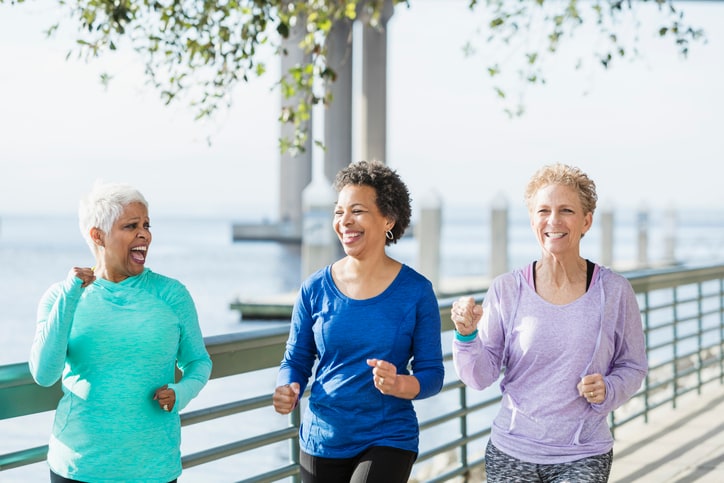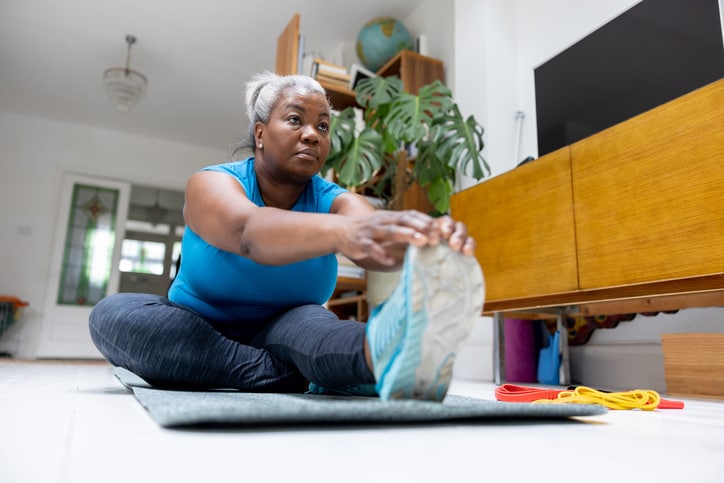In a world of expensive boutique gyms, marathon runners and pilates experts, it can be easy for seniors and senior caregivers to overlook a very basic and essential activity for health: walking. It might not be fancy, but it sure is effective.
“Walking has multiple physical benefits,” says Dr. Leonard Pianko, board-certified cardiologist in Aventura, Florida. “It’s good for your heart and an excellent way to control your blood pressure, cholesterol and sugar levels. It has also been proven to improve cognitive skills, as well as elevate your mood and clear your head.” Walking with a buddy also has an added social benefit, he adds — and it’s free.
Weeding out all the noise around exercise must-dos, equipment and know-how is quite simple when you focus on hitting your 150 minutes of weekly exercise by adding in some brisk walks. Here’s a closer look at the benefits of walking for seniors and how to establish a walking routine that works for any age or ability level.
What are the benefits of walking for seniors?
The benefits of walking go far beyond physical fitness. Here are a few of them, according to the experts.
Walking improves health and mobility
Over time, aging can contribute to joint pain, muscle aches, stiff limbs and more. For some, chronic conditions and diseases further complicate exercise, and physical limitations can get in the way of general fitness. According to a report by Harvard Medical School, walking helps to counteract the effects of weight-promoting genes. Additionally, the nonprofit foundation America Walks reports that walking can:
- Ward off heart disease.
- Lower blood pressure.
- Stop bone loss from osteoporosis.
- Improve symptoms of arthritis.
Exercise boosts mood and mental health
Beyond the physical benefits of walking, there are some social-emotional ones to consider as well. According to the Mayo Clinic, walking reduces stress and tension, as well as boosts your mood.
“Incorporating elements like nature walks or historical tours can make walking more interesting and intellectually stimulating.”
— Linda Borgmeyer, occupational therapist
“It’s important to emphasize that walking is not just a physical activity but also a great opportunity for social engagement and mental stimulation,” says Linda Borgmeyer, a board-certified occupational therapist and founder of Wisdom Warrior Challenge in Palm Beach County, Florida. “Incorporating elements like nature walks or historical tours can make walking more interesting and intellectually stimulating.”
Walking can boost confidence and self esteem
Borgmeyer suggests setting some walking goals and gamifying the process a bit through wearable fitness devices. “Technology, such as fitness trackers and mobile apps, can be a great motivator for helping you track progress and set achievable goals,” she explains.
Meeting goals and noticing progress is a great confidence booster. “It’s also worth noting that walking can be easily adapted to suit individual fitness levels and health conditions, making it a highly accessible form of exercise,” she adds.
How to build a walking routine for seniors
1. Begin with short walks
Seniors don’t have to head out for a super long or rigorous walk all at once. Instead, start slow. “Since routine is important, my recommendation is walking a minimum of three times a week,” Pianko says.
This is especially important for those who have been sedentary or are building up their stamina again. Starting slow is essential for long-term success and physical benefits. “If your activity level is generally low and you sit more than you move in a day, your muscles will need time to build up the tolerance for walking consistently,” says Borgmeyer.
“You can start a walking routine by setting small, achievable goals, like a 10-minute walk around the neighborhood, then gradually increasing the duration and distance over time,” she adds. Don’t discount incorporating walking into daily activities as well, such as walking to a store, taking a park stroll or even just parking further away from a building.
2. Level up as stamina increases
“Once you have improved your fitness level, you can reduce the number of days by instituting interval walking,” Borgmeyer says. Interval walking, which she says is safe and builds stamina, involves walking fast (whatever version of fast works for each senior) for a count of 30 seconds, then slow for a count of 60 seconds. “Do this throughout a 30-minute walk and you will notice a significant jump in fitness,” she adds.
3. Customize routines based on needs and abilities
The experts say it’s important for seniors to listen to their bodies and adjust the frequency and duration of walks based on personal comfort and health conditions.
“Listening to the body and stopping if there’s pain or discomfort is essential.”
— Dr. Leonard Pianko, cardiologist
“Consult a physical or occupational therapist if you are recovering from an injury or surgery,” Pianko says. “It’s crucial to follow a healthcare provider’s guidance to ensure that the healing process is facilitated. Listening to the body and stopping if there’s pain or discomfort is essential to prevent re-injury.”
4. Prioritize safety
“When starting a walking regimen, choose safe, well-lit routes with smooth surfaces to prevent falls,” Borgmeyer says. “It’s important to be aware of the surroundings, avoid distractions like using a phone while walking and wear bright or reflective clothing for visibility.”
Seniors and caregivers might prefer to aim for days where it’s safest to go out, avoiding snowy and icy conditions and avoiding overly hot conditions as well. Pianko adds that you can also head to a mall for a safe, smooth and warm walking experience, or look into local walking groups for a team.
5. Choose the right gear
For safe and comfortable walking, it’s important to have the right equipment. According to the experts, some gear that might be beneficial includes:
- Supportive walking shoes.
- Walking aids like canes, walkers or walking sticks.
- Appropriate clothing for the weather.
- Reusable water bottles.
- A way to call for help, such as a medical alert device or cell phone.
6. Make walking a social activity
Once you’ve addressed all the practical considerations of starting a walking routine, grab a friend and have some fun with it. “A group of residents who started a walking club in a retirement community found that their sleep quality improved and they felt more socially connected,” Borgmeyer says. The social benefits of walking are well-documented and beneficial for all age groups.
The bottom line
Borgmeyer has no shortage of success stories on the impact a walking routine has had on seniors’ mood, health and energy levels. “A 75-year-old woman shared that regular brisk walks helped her manage her arthritis pain better and increased her overall mobility,” Borgmeyer says. “Another person, who began walking daily after a minor heart scare, credited the activity with lowering his blood pressure and reducing his medication dependency.”
Not only is walking a great way to improve health and mobility, but it’s also an outlet for stress and another potential way to enrich seniors’ daily lives. Borgmeyer says, “Stories abound of people who took up walking and found it to be a gateway to exploring new hobbies and interests, like birdwatching or photography, enhancing their overall quality of life.” With so much to gain from walking, what do you have to lose?



